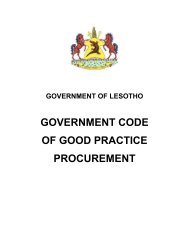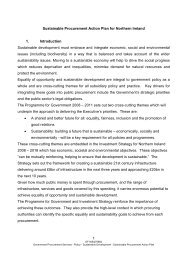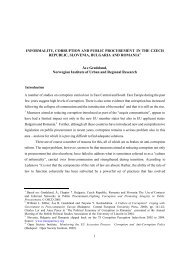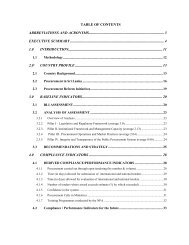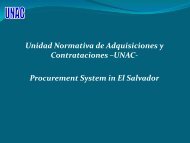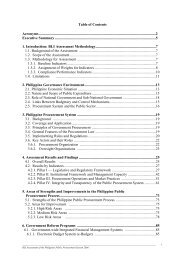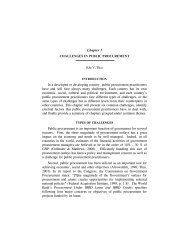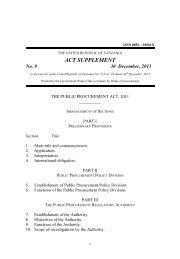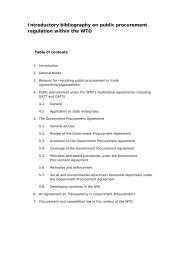Compendium of Country Examples and Lessons Learned from ...
Compendium of Country Examples and Lessons Learned from ...
Compendium of Country Examples and Lessons Learned from ...
You also want an ePaper? Increase the reach of your titles
YUMPU automatically turns print PDFs into web optimized ePapers that Google loves.
Table 4. Compliance <strong>and</strong> Performance Indicators in Zambia: a high risk areaSub-Indicator Compliance <strong>and</strong> Performance Indicator Compliance <strong>and</strong> Performance Data1 (c) Percentage <strong>of</strong> invitations for open tenders publiclyadvertised36.67%1 (e) Percentage <strong>of</strong> tenders rejected in each process. 77%1 (g) Percentage <strong>of</strong> open tenders opened publicly <strong>and</strong>recorded.6 (c) Percentage <strong>of</strong> contracts found with incomplete recordsas per the list given for this sub indicator keeping.66.66%56.67%The Philippines summarised all existing <strong>and</strong> proposed initiatives <strong>and</strong> recommendations to addressthe areas for improvement based on the BLI assessment <strong>and</strong> included other actions <strong>from</strong> earlier CPARstudies. High risk areas were identified <strong>and</strong> prioritized in the Proposed Capacity Development Plan, asshown in Table 5:Table 5. The Philippines’ proposed Procurement Capacity Development PlanHigh risk areaThere are no established norms at the national level forrecord keeping <strong>and</strong> document retention for the conduct<strong>of</strong> procurement audits or for investigating <strong>and</strong>prosecuting cases <strong>of</strong> procurement-related fraud <strong>and</strong>corruption.The absence <strong>of</strong> an administrative complaint body toh<strong>and</strong>le appeals that has full authority <strong>and</strong>independence for resolution <strong>of</strong> complaints. There is noindependent administrative body or special courtestablished to review procurement-related complaints<strong>and</strong> appeals outside <strong>of</strong> the courts.Proposed Capacity Development PlanThe Capacity Development Plan will include aprogramme for the establishment <strong>of</strong> policies <strong>and</strong>procedures for record keeping <strong>and</strong> management forprocurement, contract <strong>and</strong> financial managementrelatedtransactions for government agencies.A review <strong>of</strong> policies <strong>and</strong> procedures for procurementrelatedcomplaints <strong>and</strong> appeals will be conducted withthe following options:a) to study other countries’ best practices;b) to create, possibly, an independent administrativereview body;c) to mine the expertise <strong>of</strong> an existing administrativebody with the appropriate m<strong>and</strong>ate; ord) to review the reasonableness <strong>of</strong> the protest fee.In the proposed Procurement Capacity Development Plan, medium risk areas <strong>and</strong> low risk areas were alsoaddressed. The plan indicates a key result area <strong>and</strong> recommended action/measure. On an action/measure base itspecifies the following: BLI indicator; specific weaknesses; responsible entity; funding source; schedule.Establishing a capacity development planMany pilot countries have used the assessment results to draft a capacity development plan.Recommended actions address the individual level, the organisational level <strong>and</strong> the enablingenvironment. Box 10 gives an exemplary list <strong>of</strong> capacity building measures which correspond to thedifferent levels as presented in the individual assessment reports on h<strong>and</strong>.50 COMPENDIUM OF COUNTRYEXAMPLES AND LESSONS LEARNED […] - © OECD 2008



